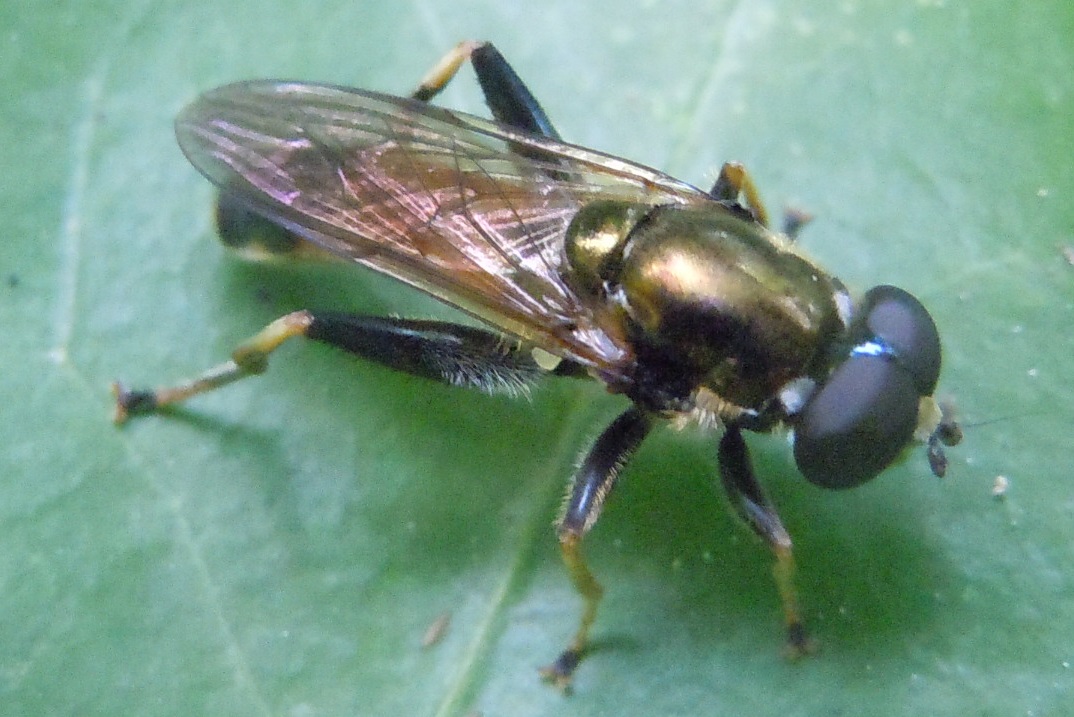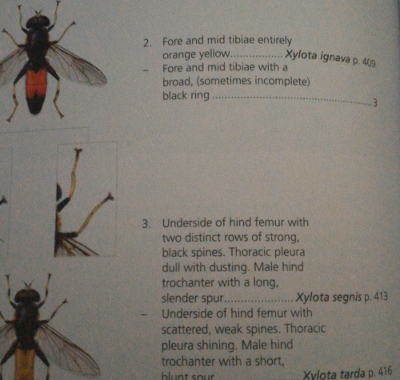|
|
|
|
|
Galleria Tassonomica
di
Natura Mediterraneo
|
 Nota! La determinazione degli insetti necessita quasi sempre di un'indicazione geografica e temporale precisa. Nota! La determinazione degli insetti necessita quasi sempre di un'indicazione geografica e temporale precisa.
Invitiamo quindi gli utenti ad inserire questi dati ogni volta che viene richiesta una determinazione o viene postata una foto di un insetto. I dati forniti dagli utenti ci consentiranno anche di attribuire un valore scientifico alle segnalazioni, contribuendo a migliorare e integrare le attuali conoscenze sulla distribuzione delle specie postate.
|
|
| Autore |
 Discussione Discussione  |
|
|
Mizar
Utente Super
    
Città: Napoli
Prov.: Napoli
Regione: Campania

12045 Messaggi
Tutti i Forum |
|
|
Mizar
Utente Super
    
Città: Napoli
Prov.: Napoli
Regione: Campania

12045 Messaggi
Tutti i Forum |
 Inserito il - 29 luglio 2016 : 19:53:11 Inserito il - 29 luglio 2016 : 19:53:11


|
Immagine:

228,93 KB |
Verrà il giorno in cui uccidere un animale sarà considerato un delitto al pari di uccidere un uomo. (Leonardo da Vinci) |
 |
|
|
ValerioW
Moderatore
    

Città: Padova
Prov.: Padova
Regione: Veneto

8065 Messaggi
Tutti i Forum |
 Inserito il - 29 luglio 2016 : 23:16:16 Inserito il - 29 luglio 2016 : 23:16:16


|
| X. ignava maschio |
爱 自 然 |
 |
|
|
Mizar
Utente Super
    
Città: Napoli
Prov.: Napoli
Regione: Campania

12045 Messaggi
Tutti i Forum |
 Inserito il - 30 luglio 2016 : 00:50:57 Inserito il - 30 luglio 2016 : 00:50:57


|
Grazie Valerio ! Ma come si distingue X. segnis da X. ignava??? ! Ma come si distingue X. segnis da X. ignava???
|
Verrà il giorno in cui uccidere un animale sarà considerato un delitto al pari di uccidere un uomo. (Leonardo da Vinci) |
Modificato da - ValerioW in data 30 luglio 2016 09:50:29 |
 |
|
|
ValerioW
Moderatore
    

Città: Padova
Prov.: Padova
Regione: Veneto

8065 Messaggi
Tutti i Forum |
 Inserito il - 30 luglio 2016 : 09:51:06 Inserito il - 30 luglio 2016 : 09:51:06


|
| Messaggio originario di Mizar:
Grazie Valerio ! Ma come si distingue X. segnis da X. ignava??? ! Ma come si distingue X. segnis da X. ignava???
|
In questo caso le tibie I e II non sono compatibili. La specie che indichi tu (insieme ad altre), le ha con zone scure, mentre nelle tue foto sono totalmente gialle (o comunque chiare).
(per sbaglio ho cliccato "modifica", invece di "rispondi"...per cui il tuo messaggio appare come modificato, anche se non l'ho modificato  ). ). |
爱 自 然 |
 |
|
|
chlorophana
Utente Senior
   
Regione: France

1186 Messaggi
Flora e Fauna |
 Inserito il - 30 luglio 2016 : 12:29:28 Inserito il - 30 luglio 2016 : 12:29:28


|
I disagree with you Valerio. The tibiae colour is not used to separate X. segnis from relative species ; in this case the long and well separated spine-like bristles on ventral part of hind femur are characteristic of X. segnis. The other species with reddish coloration on abdomen like X. ignava and X. tarda have tight minute spines.
So it is Xylota segnis. |
|
 |
|
|
ValerioW
Moderatore
    

Città: Padova
Prov.: Padova
Regione: Veneto

8065 Messaggi
Tutti i Forum |
 Inserito il - 30 luglio 2016 : 13:46:18 Inserito il - 30 luglio 2016 : 13:46:18


|
| Messaggio originario di chlorophana:
The tibiae colour is not used to separate X. segnis from relative species
|
I'm sorry Stephane, but is not like you said. Check this.
Immagine:

166,62 KB
And Stephane, also remember that X. segnis should have those spines not over 1/2 of femur 3 length (while here they appear to go really beyond 1/2). So, for me it is still X. ignava. |
爱 自 然 |
 |
|
|
chlorophana
Utente Senior
   
Regione: France

1186 Messaggi
Flora e Fauna |
 Inserito il - 30 luglio 2016 : 14:39:41 Inserito il - 30 luglio 2016 : 14:39:41


|
I assume this yellow coloration of the fore tibiae can be not as reliable as the spines character that is quoted in all references Syrphidae keys (Verlinden, van Veen, Falks etc.). Moreover, from this angle of view, it can be difficult to make sure of this coloration with certainty.
X. ignava, moreover (even if the long spines character is sufficient), should have the distal end of hind tibia orange (not only the basal part), and the whole hind tarsus, except last segment should also be orange.
See : Link
To be compared with X. segnis : Link
|
|
 |
|
|
ValerioW
Moderatore
    

Città: Padova
Prov.: Padova
Regione: Veneto

8065 Messaggi
Tutti i Forum |
 Inserito il - 30 luglio 2016 : 15:15:48 Inserito il - 30 luglio 2016 : 15:15:48


|
| Messaggio originario di chlorophana:
X. ignava, moreover (even if the long spines character is sufficient), should have the distal end of hind tibia orange (not only the basal part), and the whole hind tarsus, except last segment should also be orange.
|
Nope my friend. From the picture I added it doesn't look like you said. Tibia 3, in ignava, has a black spot.
Here, you can see in diptera.info gallery how it is
Link
...or check this quite unusual segnis, identified again in diptera.info gallery
Link
I think we are in a speculative field, whatever is, Tibiae 1 & 2 colours first or femur 3 spines first. For ex. I've always seen segnis with a tibia like this one (this of Mizar), very curved...but it isn't a character really much used in keys. I think this is a quite unusual segnis, considering spines first, or ignava if I put bigger relevance to tibiae 1 and 2 colours...in both cases the speciment has some atypical characters |
爱 自 然 |
 |
|
|
chlorophana
Utente Senior
   
Regione: France

1186 Messaggi
Flora e Fauna |
 Inserito il - 30 luglio 2016 : 15:45:46 Inserito il - 30 luglio 2016 : 15:45:46


|
| Nope my friend. From the picture I added it doesn't look like you said. Tibia 3, in ignava, has a black spot.
Here, you can see in diptera.info gallery how it is |
So we 100 % agree together, because I said : basal and distal part orange (that's imply black between).
To have an other opinion (and not undergo our never-ending discussion), Mizar can ask on Diptera.info or directly to one of the numerous Syrphidae specialists (I'm not one) like Gerard Pennards, Cyrille Dussaix, Martin Speight, Steven Falk, Roger Moris etc.
Saluti,
Stéphane. |
|
 |
|
|
Mizar
Utente Super
    
Città: Napoli
Prov.: Napoli
Regione: Campania

12045 Messaggi
Tutti i Forum |
 Inserito il - 30 luglio 2016 : 15:51:20 Inserito il - 30 luglio 2016 : 15:51:20


|
Intervengo solo per specificare che i soggetti sono due esemplari differenti, posizionati a mezzo metro l'uno dall'altro. Se in entrambi si riscontrano caratteri anomali, ne deduco che forse è una popolazione "anomala". Cosa che non mi sorprenderebbe troppo considerate le peculiarità del cratere(isolamento geografico, microclima caratteristico, ecc).
Segnalo inoltre, l'unica discussione del forum in cui è stato identificato X. ignava : Link |
Verrà il giorno in cui uccidere un animale sarà considerato un delitto al pari di uccidere un uomo. (Leonardo da Vinci) |
Modificato da - Mizar in data 30 luglio 2016 15:54:21 |
 |
|
|
ValerioW
Moderatore
    

Città: Padova
Prov.: Padova
Regione: Veneto

8065 Messaggi
Tutti i Forum |
 Inserito il - 30 luglio 2016 : 16:23:48 Inserito il - 30 luglio 2016 : 16:23:48


|
| Messaggio originario di chlorophana:
So we 100 % agree together, because I said : basal and distal part orange (that's imply black between).
|
Ehmmm, no again  ...for example, in anatomy, when you are referring to a limb or any other body part you can consider it with a 'basal' (or proximal, or cranial etc.) half and with an 'apical' (or distal, or caudal etc.) half. Between them there is nothing. Or, if you say 'basal part pale', doesn't necessary mean that the rest is dark; for sure means that this should be pale. ...for example, in anatomy, when you are referring to a limb or any other body part you can consider it with a 'basal' (or proximal, or cranial etc.) half and with an 'apical' (or distal, or caudal etc.) half. Between them there is nothing. Or, if you say 'basal part pale', doesn't necessary mean that the rest is dark; for sure means that this should be pale.
The real answer to this kind of dubt, I mean about a strict relationship between animal individuals, is molecular biology/genetics. Keys, physical characters more or less have a speculative/subjective basis.
BTW: In many fly species there are many mechanisms to prevent interspecific breeding, and sensory stimuli play an effective role ... so for sure I don't mean that physical characters are not important to distinguish animals. |
爱 自 然 |
 |
|
|
Mizar
Utente Super
    
Città: Napoli
Prov.: Napoli
Regione: Campania

12045 Messaggi
Tutti i Forum |
 Inserito il - 10 settembre 2016 : 09:24:40 Inserito il - 10 settembre 2016 : 09:24:40


|
Ho seguito con interesse il dibattito tecnico, ma...si è giunti a un accordo ? ? |
Verrà il giorno in cui uccidere un animale sarà considerato un delitto al pari di uccidere un uomo. (Leonardo da Vinci) |
 |
|
|
Mizar
Utente Super
    
Città: Napoli
Prov.: Napoli
Regione: Campania

12045 Messaggi
Tutti i Forum |
 Inserito il - 25 agosto 2017 : 20:16:12 Inserito il - 25 agosto 2017 : 20:16:12


|
Ho chiesto un parere anche su diptera.info, mi suggeriscono Xylota segnis: Link |
Verrà il giorno in cui uccidere un animale sarà considerato un delitto al pari di uccidere un uomo. (Leonardo da Vinci) |
 |
|
| |
 Discussione Discussione  |
|
|
|
 Natura Mediterraneo Natura Mediterraneo |
© 2003-2024 Natura Mediterraneo |
 |
|
Leps.it | Herp.it | Lynkos.net
|

 Forum
|
Registrati
|
Msg attivi
|
Msg Recenti
|
Msg Pvt
|
Utenti
|
Galleria |
Map |
Forum
|
Registrati
|
Msg attivi
|
Msg Recenti
|
Msg Pvt
|
Utenti
|
Galleria |
Map |